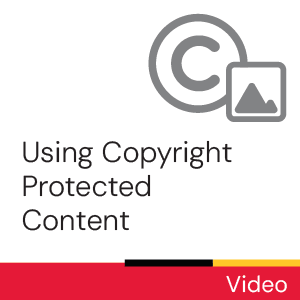Time commitment
Less than 2 minutes
Description
This video will show you how fair dealing may apply to you as a student or researcher, and what criteria are considered 'more' or 'less' fair when using others' work for educational or research purposes.
Video
Transcript
Fair Dealing with Copyright-protected works
This video will explain how you, as a student or researcher, can use the fair dealing exception in Canada’s Copyright Act to enable the copying and use of the copyright-protected works of others such as when you are including portions of someone else’s work in your own creation.
Copyright applies to all types of works, including content found on the internet. This is true even if the copyright symbol isn’t visible. If you are copying and sharing someone else’s work, the copyright owner’s permission is usually required.
However, an exception in Canada’s Copyright Act, known as “fair dealing”, allows for the reproduction of copyrighted works for certain purposes without needing to seek permission or pay a fee.
Some of the purposes for which fair dealing is allowed include research, private study, education, criticism, and review.
So, if you need to use a specific image, figure, quotation, or video clip from another work, in order to critique, analyze or examine it in your own work, or if you need to copy portions of a work in order to help you study, or do research, fair dealing can enable these kinds of uses.
Once you have determined that your use of a work is for one of the fair dealing purposes, you also need to determine if your use of the material in question is fair.
Canada’s Supreme Court provides guidance on what is considered ‘more’ or ‘less’ fair when using a work under fair dealing.
Copying short excerpts of a work tends to be more fair than copying large portions. Only use the portion of the work that is necessary to achieve your purpose. This might be a quotation or several pages from a text, or a short clip from a movie or a sound recording.
Copying for a non-commercial or educational purpose is more likely to be fair.
Copying a work will be fairer if there is no reasonable alternative. If you could have used openly-licensed or copyright-free content instead, your use may not be fair.
[Public domain license and creative commons mark.]
Making a copy for personal use, or to share with a limited audience, is more likely to be fair than sharing the content widely, such as on a public website.
And finally, your use is also more likely to be fair if it doesn’t impact the market for the original work. Copying and sharing a substantial part of someone’s work could have a detrimental effect on the sales of the original.
In order to evaluate the fairness of your use, these considerations need to be weighed together. Some of the factors may be more applicable to your situation than others.
[Words appear on screen: ‘character of use, purpose, nature of work, alternatives, effect on the market, amount’.]
And remember, whenever you use someone else’s work, always cite the source and credit the author or creator.
While fair dealing is an important tool that allows you to make use of copyrighted works in your class assignments or research papers, other types of uses may require you to obtain the copyright owner’s permission.
[A person walking into a building labelled 'publisher'.]
Check out the library’s copyright web pages for more information about Fair dealing and other exceptions in the Copyright Act.
Need more help? You can click, chat, call, or drop by!
License

This work is licensed under a Creative Commons Attribution-NonCommercial-ShareAlike 4.0 International License.
Recommended
- Ask Chat is a collaborative service
- Ask Us Online Chat hours
- Contact Us

